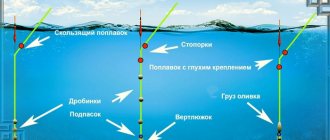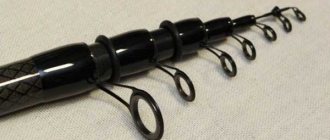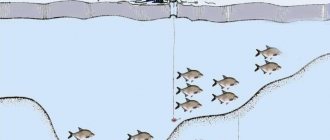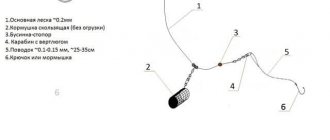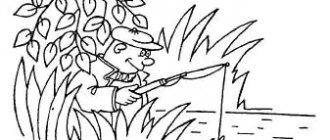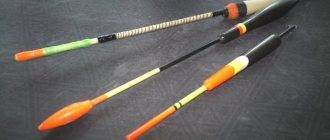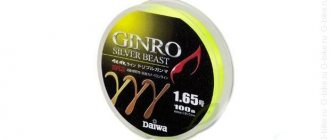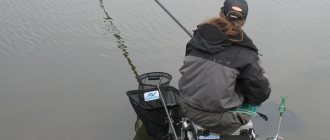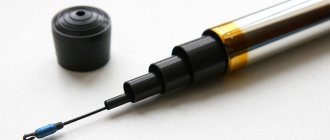General information
For successful fishing in the current, the simplest equipment with a minimum set of necessary materials may be suitable.
| Equipment components | Note |
| Rod | You can choose flywheel, Bolognese, match or plug |
| Coil | Both inertial and inertial-free models are used |
| Main line | Suitable fishing line with a diameter of 0.15-0.20 |
| Float | Load capacity depends on the number of weights used |
| Lead pellets | It is better to take a set, as you may need several sizes of pellets |
| Rubber cambrics | You will need several pieces |
| Lead line | Should be thinner than the main one - diameter approximately 0.1-0.13 |
| Hook | For medium-sized fish, you will need a hook size from 6 to 10 (according to the international classification). You should choose a hook that can fit in the mouth of a fish living in a pond. |
The sequence of rigging a float rod is as follows:
- If the rod involves the use of a reel, then at the first stage it is fixed in the required place. For types of fishing rods that are designed for fishing without a reel, the main line will be attached to the tip.
- A fishing line about 50 meters long is wound onto a reel. After this, the end of the fishing line is threaded through the guide rings, starting from the one closest to the reel and to the tip.
- The float is put on the fishing line first, followed by a rubber casing into which the keel of the float is inserted.
- The shipment is carried out - the pellets are secured on the fishing line. To create the most sensitive equipment, it is better to place the pellets at some distance from each other and with a decrease in weight towards the hook. That is, the smallest sinker should be at the bottom (immediately in front of the leash), and the largest at the top.
- A leash with a hook is attached to the end of the main line. Fastening can be done using the loop-to-loop method or using a swivel with a carabiner.
Important! The catchability of gear for fishing in the current depends on the correct choice of the type of rod and float. Second in importance is the choice of baits and bait, as well as the fishing technique used.
Baits and baits for the current
The baits should stick well to the hook. Worms, bloodworms, maggots, caddis flies, chafer larvae, bark beetles, leech, grasshoppers are baits of animal origin that successfully resist the current. Nozzles of plant origin: pearl barley, mastyrka, corn, millet. All treats should be fresh and attractive to fish. In order not to leave empty-handed, it is best to have at least 5 different baits with you. From some you can make a “sandwich”, that is, combine together, for example, a worm and maggot.
If the fishing place is unfamiliar, then it is best to walk along the shore and find a hole. It is at the difference in depth that large fish hang on. Swirls and eddies will help you find a good fishing spot. All that remains is to tap the bottom, feed and start fishing.
Which float rod should a beginner choose?
When fishing with a float in the current, one of the following types of rods is used:
- Bolognese. Excellent even for low to medium current conditions. Due to its impressive length and the ability to use large reels, you can send the equipment downstream, expanding the boundaries of the selected fishing location.
- Match. Available in two types: composite and telescopic. Depending on the model, they can have a length from 4 to 7 meters. Comes with reels. The main feature of match rods is the ability to make long casts and fish in deep rivers.
- Flywheel. It is considered a classic option for fishing on the river from the shore or boat. The length of such rods can be from 4 to 12 meters. The main feature is the limited casting range, due to the fact that the equipment is attached to the end of the fishing rod (a reel is not used).
- Plug-in. They are very similar to flywheels and are their improved versions. The length of plug fishing rods can reach 20 meters. Opens up great opportunities in cases where the longest casts are required or fishing is expected at impressive depths.
Some types, such as plug rods, are used only by professional sportfishers. If you are just learning the basics of float fishing in the current, it is better to opt for the fly option. These fishing rods are considered universal and are as easy to use as possible.
Fly, Bolognese, plug and match rods are suitable for fishing in currents
Sports floats
The next type of floats used in current fishing are sports floats. They are the most versatile type of floats. Due to the fact that their structure contains a ring that connects the antenna and the body of the float, as well as a cambric installed at the bottom of the keel. With the help of such elements, the float is easily adjusted on the water.
In addition, a low center of gravity makes it possible to reduce the sensitivity of the float in the current, since in general this type of float is characterized by a fairly high sensitivity. The higher the sensitivity of the float, the better it will adapt to the current in the reservoir. Accordingly, when choosing a float, you should pay attention to the ring, as well as its location.
If the ring is located close to the body of the float, that is, at the bottom of the antenna, then the float will be more sensitive than a float with a higher ring on the antenna.
That is, sports floats have the following qualities:
- Sustainability.
- Sensitivity.
- Elongated shape.
- The ability to adapt to the flow.
- Low center of gravity.
- The presence of a ring on the antenna and a cambric on the keel.
- Different location of the top ring.
Choosing a float for fishing in the current
Exposure to water flow can change the behavior of the float beyond recognition. That is why for river fishing it is recommended to choose special floats suitable for use in currents.
If you are used to fishing in still water, then you have already appreciated the advantages of goose feather and needle floats. With a current, even a slight one, such structures will be completely ineffective - the waves roll them over to one side and, as a result, the floats lie almost parallel to the water surface. Current fishing conditions require a special approach to choosing a float, starting with its design to optimally reduce the negative influence of waves. It is worth paying attention to universal options with the following features:
- egg-shaped (or pear-shaped) with a thin long rod and 2-3 attachment points;
- the body of the float should be located closer to the top edge (serves as a control element);
- the antenna should be much smaller in size than the keel (this will allow the structure to be kept in an upright position even with overactive currents).
It is very important to correctly decide initially on the shape of the body of the float, which will become universal for use in the current, even in windy weather conditions. Drop-shaped models with short antennas meet these characteristics.
Flat floats
Relatively new fishing bite alarms, which have already gained incredible popularity, in particular among fans of plug rods. The almost perfect hydrodynamic shape reduces water resistance to the minimum possible. Even in such powerful currents as on a mountain river, the flat float takes the desired position, remains in an upright position and signals even the most cautious bites.

A flat float made by yourself is not inferior in quality to a purchased one.
Important! The main features of flat floats are a flat body, similar to a disk (it turns with an edge towards the current and, as it were, cuts it, significantly reducing resistance) and a keel installed at an angle (under the influence of the current, it does not allow the structure to heel, keeping it in a vertical position).
Initially, this type of float was recommended only for rivers with active currents. Appropriate loading made it possible to use them in a wide variety of conditions, including in still water when fishing for even the most cautious and timid fish in calm weather and in rain.
Choosing a float depending on the intensity of the current
When trying to catch trophy river fish, it is necessary to take into account all the nuances. One of the subtleties is the correct selection of the weight of the float for flows of different speeds/intensities. In this case, the following recommendations will be useful:
Fishing in early spring with a float
- For weak currents. Floats that can withstand a load of 4 to 8 grams are suitable. It is very important to pay special attention to loading, using heavy and light pellets at a distance of at least 20 cm from each other. In this case, the bait smoothly sinks into the water without scaring the fish and at least 10 cm of the leash should lie quietly on the bottom. With such equipment you create conditions under which it is easy to notice bites from even the most cautious individuals of chub, roach and ide.
- For middle flow. You will need a float with a carrying capacity of 6 to 20 grams, which should be used with a leash of at least 60 cm and no more than 150 cm in length (it is assumed that most of it will lie on the bottom). When loading the pellets, it is necessary to place them closer to the leash and make the distance between them no more than 10 cm. Such equipment in the middle current holds the float in a comfortable vertical position and will promptly notify you of bites from carp and bream.
- For strong currents. It is necessary to use a stable float with a load capacity of 8 to 40 g. The length of the leash increases to two meters and the pellets are moved closer to the bottom of the main line during shipment. In order for the finished equipment to be carried away by the current as slowly as possible, it is recommended to hold the spool with your finger when casting and after it, or even block it with the reel bail. This option is great for catching large carp and bream.
Such recommendations can be considered general, combining the main principles of fishing in the current. To get the desired catch, it is better to experiment not only with the bait, but also with the equipment - to quickly remove and replace it, use a mount with micro-swivels.
Donka fishing tackle with ring
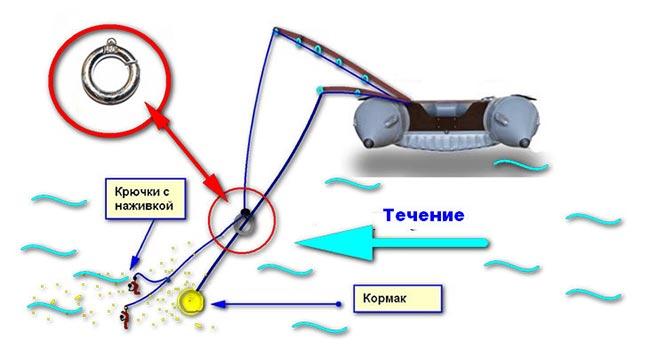
A current bottom with a ring is the most effective type of bottom gear used by fishermen, but it is used only if a watercraft is available. The peculiarity of this donkey is that, thanks to the presence of a ring that slides along the cord from the boat to the bait, the feeding of the hooks with the nozzle is very accurate.
The irritant in the form of a feeder with a bait mixture is thrown first and attracts the fish to the place where the ring with leashes tied to it is fed. It is very difficult for fish not to be tempted by such a treat, but when fishing with a ring, large trophies are rarely caught.
The tackle is coarse and it is convenient and easy to catch small fish, but it is more difficult to catch river carp or carp. On the other hand, when fishing with a donkey with a ring, it is easier for the fisherman to control the equipment, there is no need to make any casts, and there are no difficulties in the process of landing fish. A donka with a current ring is a homemade tackle and you can’t buy one in a store; it is tied quickly, just as it is prepared for fishing.
On a note! The donka with a ring can also be caught in still water, but it is during the current that it shows all its advantages.
Float fishing technique in the current
Universal equipment options are designed for conditions with a depth at the fishing point of no more than three meters. It is very important, even when installing the equipment, to determine exactly what kind of fish you plan to go for - crucian carp, ruffe, silver bream, perch or bream, which, according to their natural way of life, feed from the bottom or on high water, rudd or bleak, which are best caught in the water column or near the surface .
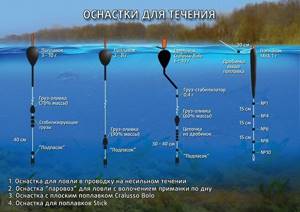
There are many options for equipment. Based on the basic principles of their installation, you can choose the best option for any body of water with a current.
The choice of optimal equipment (including the length of the leash) and the particular position of the hook on the bottom will depend on what kind of fish you are targeting. But the number of bites and the success of fishing in general depends on these parameters. There are some general recommendations that can be taken as a basis when preparing for your next trip to the river:
- roach - large specimens do not bite very often, but on the bait, which is as close as possible to the bottom (the dragging edge);
- bream - in order to interest it, use dragging along the bottom;
- dace - use equipment that will ensure the bait floats at some distance from the bottom (about 5-20 cm);
- ide - will be interested in a bait that constantly moves in the near-bottom water column (no higher than half a meter from the bottom).
Recommendations related to the characteristics of the water in the river can be considered common to all types of fish - in clear water, the retrieve can be carried out higher (further from the bottom), in muddy water - as close to the bottom as possible, including dragging.
Determining the fishing location
If you have experience in fishing on a specific section of the river, and you know the leashes of local fish well, and have studied the bottom topography, then you can safely begin starting feeding and fishing. If you don’t have such knowledge, then it’s better to find an area with a fast current, near a hole. In such places there is usually a reverse current and whirlpools. Be sure to tap the bottom and determine the depth and structure of the bottom. It would be nice to find a coastal dump. Bream, roach and other white fish like to stay there. If you can find an edge close to the shore, that will also be very good. Having fed the area behind the edge, you can count on a good bite.
In late spring and early summer, chub are very active. They catch it behind the rifts and in the coastal zone near trees on a rocky and sandy bottom. It is not even necessary to use a lot of bait. It is enough to throw a few handfuls of pearl barley or wheat near a riffle and fish in the wire with a cockchafer or a bark beetle larva, maggot or caddisfly. It is not easy to identify promising areas with a current when you are on a reservoir for the first time. In such cases, the emphasis should be on places with sharp changes in depth with a changing structure of the bottom relief. For example, fishing at the border of a shell and a muddy bottom. Sometimes the very process of searching for a fishing spot gives the fisherman a lot of useful information, and he gains useful experience. Successful finds give the fisherman confidence, and in subsequent times he quickly finds promising areas in such places.
Basic fishing methods
When planning to go fishing in winter, summer or early spring and fish from the shore or boat, it is important to choose the right fishing method. The choice of equipment and, as a consequence, effectiveness will depend on this.
Demolition fishing
One of the most popular and frequently used methods of fishing on rivers with small and moderate currents, in particular when fishing from capes. Its essence lies in the fact that the casting is carried out perpendicular to the shore or slightly upstream. After casting, the float must be floated down 20-30 meters.
The advantages of the drift fishing method include the fact that you will be in contact with the float - the line will be taut. These are excellent conditions for timely and effective cutting. This method does not work very well in downstream winds, but in this case lightweight floats can improve the situation.
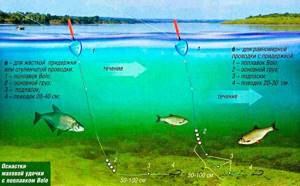
Flat float options
In front of
More complex compared to the previous method. The bottom line is that the cast is carried out upstream (5-20 meters above your location on the shore), then the wiring is made, which ends downstream (at the same distance - 5-20 meters). For complete control over your actions, it is recommended to use this method in weak or moderate currents, but when the wind blows against the current.
The key is to keep a minimum length of line between the float and the rod tip. This can be achieved in one of two ways:
- Special equipment is the use of a fairly thin main line in combination with a heavy float.
- Manipulations when casting - lay the line against the current, and after the current weakens it, reel in the slack by making several turns of the reel.
The second method is suitable not for beginners, but for experienced fishermen who skillfully handle gear.
Fishing from a boat
The method is similar to drift fishing described above, but without the need for casting. The tackle simply falls with the current, and you constantly slow it down so that the line unwinds from the reel little by little. Drum-type inertial coils will come in handy here, but once you get the hang of it, you can use inertia-free ones without any problems.
Winter fishing rods for current
On low and medium-force drafts, the same methods are used as in calm water, only with adaptation to the current. You can also use active fishing with a jig on a weak current. A slight draft even improves fishing capabilities - the jig can be launched under the ice using a step (pull). You'll just need a slightly rougher nod than usual. Therefore, a slight draft is not a reason to put off fishing with a jig in the current in the box. On riverbed streams of great force, heavy gear is used.
Winter feeder, roller, helicopter (wing) work effectively where it is impossible to fish with a regular fishing rod. Such rigs are very different from the usual ice fishing rods, just like a summer float is different from a zakidushka. All these gear are discussed in detail in articles on our website. In this publication we will look at winter fishing rods for stationary fishing on rivers. It is advisable to use them on low draft or smooth flow of medium strength.

Fishing rods
The difficulty is that the correct sensitive installation of a winter fishing rod for fishing in the current cannot be found at home in a jar of water. This can only be done on a reservoir in real conditions, taking into account the strength of the flow and depth. A winter rod for the current requires a more massive one; a light balalaika will be moved or turned over by the stream with the whip down. Therefore, we choose fishing rods that are more massive and heavier. Standard store-bought fishing rods with a handle will do. It is better to immediately screw a lead plate onto the sole of the handle with a self-tapping screw for counterweight, since the fishing rod’s own weight may not be enough to hold the tackle.
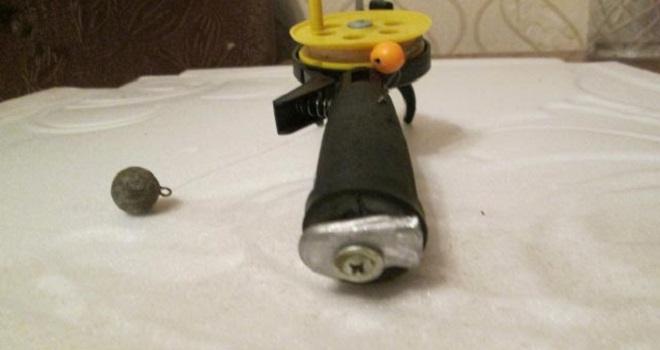
Handle weight
Floats and nods
The ultimate goal of manipulating the equipment is to obtain a sensitive system that, despite the traction, qualitatively transmits the fish bite to the alarm, float and nod. At the same time, in general, a winter fishing rod for currents is made heavier than for still water. A larger float is required to hold a heavy sinker or jig. The nod also needs to be coarser, but when working with it, the angler must clearly distinguish between bending from the bait touching the bottom, biting and simply pulling on the line loop.

Preserving the sensitivity of the equipment
Regardless of installation, the main task is to maintain the sensitivity of the gear. To do this, the equipment is mounted so that the rod does not inflate the large loop between the float (nod) and the load - otherwise the bite will not be visible. On thick ice, there may be a kink of the fishing line over the lower edge of the hole glass - this should not be allowed. To combat the bend, the following actions will help:
- The overall weight of the equipment means the float is larger and the load is correspondingly heavier. We strive for a smaller traction loop.
- The use of a large diameter ice drill, while in the working position the fishing rod is installed closer to the edge of the hole against the current.
- The most effective method is to drill a hole obliquely, from top to bottom in the direction of the flow.

